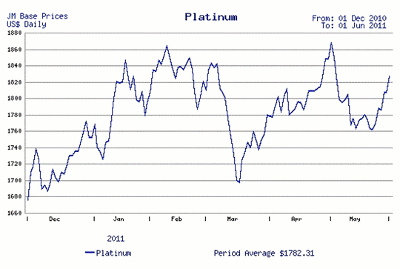While much of the focus in precious metals is limited to gold and silver, platinum is a “screaming bargain” at current levels, and strong fundamental factors are at play that could spark an epic rally.
The platinum market has waffled along since the Japanese tsunami and earthquakes on March 11 and is currently undervalued by a number of measures.
Initially, the platinum market sold off hard as industrial demand for automakers came to a screeching halt. Japanese auto production was cut by more than half and was just beginning to come back online four weeks ago. It is very reasonable to expect that Japan’s outright auto production may be cut by more than 10% for 2011.
This uncertainty has placed the platinum market in a state of limbo for the last two months. Here’s a daily chart for platinum:
There are several clues pointing towards higher prices for platinum. The first group to step in and provide a floor was the commercial traders.
The advantage of following the commercial traders is that they all derive their valuations individually. Their actions as a group, as reported to the Commodities Futures Trading Commission (CFTC), allow us to view their collective consensus. Their analysis showed that platinum below $1,700 per ounce was a screaming bargain. They increased their collective net-long position by more than 100% in two weeks.
Commodity fund managers and commodity trading advisors are following the commercial traders’ lead and have now repurchased the positions they sold off during the market’s post-nuclear freefall in March.
Platinum’s relative valuation to other precious metals is also a good indicator of value. I think everyone would agree that platinum is more expensive than gold. After all, gold production is measured in metric tons while platinum’s production is measured in ounces.
Yet, March’s decline brought the price of platinum to within $239 of the price of gold. That is a premium of 1.15 times the value of gold for a market that is 36 times the size based on 2010’s production numbers. The average annual low value for this differential is 1.52. This means that the closest platinum has been to gold in each of the last ten years is 1.52 times the value of gold.
NEXT: How High Can Platinum Prices Go?
|pagebreak|Gold at $1,000 per ounce equals platinum at $1,520. Conversely, the average high in each of the last ten years is platinum trading at twice the value of gold. A reversion to the lows of this spread brings platinum back up to $2,356 per ounce, while a move to the highs of this spread would take platinum to more than $3,000 per ounce.
Finally, Japanese auto manufacturing will come back online. Furthermore, the increase in automotive production from India, China, and Russia, which all use platinum technology in their catalytic converters, will not only support the market, but will add new demand going forward.
Remember, China now produces more cars than the US, and Japanese auto manufacturing uses approximately .054 ounces of platinum per vehicle. Based on their annual production of 9.5 million vehicles, this equals about 8.5% of global platinum production.
China and India both saw vehicle production increases of more than 25% last year, and based on their extremely low per-capita vehicle ownership rates and healthy economies, there’s no reason their increases won’t continue for some time to come.
Finally, the US government’s low-emission vehicle mandate to put ten million new, fuel-cell equipped vehicles on the road by 2025 has continued to place solid demand on platinum through its use in batteries and fuel cells. The government money being funneled into inefficient technology is pulling platinum from the market at a rate of ten times the conventional auto industry on a per-unit basis.
Whether platinum is viewed as an outright value investment or as a relative investment to other precious metals, it ought to be considered as a small percentage of one’s portfolio.
Outright platinum ownership is the most risky route with support expected somewhere around the $1,700 area, but the platinum spread against gold would afford some directional protection while still maintaining the ability to participate in platinum’s outperformance of gold as it climbs back to its historical trading levels.
By Andy Waldock of Commodity & Derivative Advisors




















